FNR Field Report: Fran Rivas
Students from Purdue Forestry and Natural Resources took their classroom knowledge to the field for summer internships and paid positions as well as research opportunities across the world, gaining valuable experience, hands-on training and career guidance. The FNR Field Reports series will offer updates from those individuals as summer positions and experiences draw to a close. 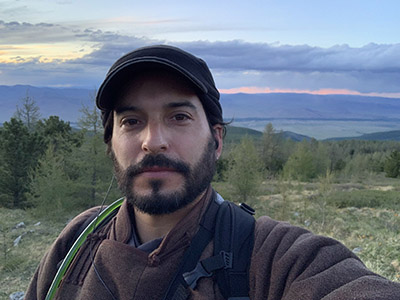
PhD student Francisco Rivas Fuenzalida spent the summer in Mongolia conducting research on soundscapes and the sonic practices of traditional herders in remote rural locations of the Arkhangai Province, alongside fellow PhD student Sam Lima and Dr. Bryan Pijanowski.
Fran brings a unique perspective to the Pijanowski lab and to the research in Mongolia, having completed his undergraduate degree in music education from Universidad de Playa Ancha in his native Chile. He always had an interest in nature and sound, but could not complete advanced study in his home country.
“Because my country’s universities are more traditional, if you don't have a science background, they won't allow you to start a master’s or PhD in something related to science,” he explained. “But here some universities and labs are starting to acknowledge the value of having people with different backgrounds and visions and what they can bring to the research.
“Partly why I chose to be a music teacher was because we had almost two months of paid vacation, so that gave me the chance to pursue my other passions, in this case, the sounds of nature, so I did my own research on bioacoustics, self-taught. In 2014, I came to the U.S. for a workshop on recording the sounds of nature and then I couldn't stop. I was struggling to keep my duties as a teacher while at the same time starting to write papers on bioacoustics, so eventually I decided that I should focus on this. Fortunately for me Dr. Pijanowski had previous experience with both PhD students and postdocs coming from a musical background, so he knew that we were a good fit for the lab, which also focuses on the cultural role of sound. It's a pretty transdisciplinary lab, so I was fortunate enough to have met him as well as my labmates and I’m grateful for the opportunity to come here to pursue my PhD.”
The work on soundscapes in Mongolia was planned before Fran arrived at Purdue, but the opportunity to travel the world was part of what drew him to the lab, even if he had to wait out the pandemic to begin working out in the field.
“One of the reasons that I came to this lab was that I knew that Dr. Pijanowski managed to produce research projects in different corners of the world and that was very exciting,” he said. “But then COVID-19 happened. I arrived here in the middle of pandemic in 2020 and I got locked down for several months without traveling for the first two years. It was a little bit hard for me because the idea of traveling was very exciting, but eventually this thing that we were talking about for years finally happened. This fieldwork was not just about doing the research and the specific tasks, but just being in these marvelous places was super rewarding. Every sunset was incredible. I couldn't take enough pictures of them. Getting to know the people there was also amazing. Learning about their history and the culture was a very enriching experience.”
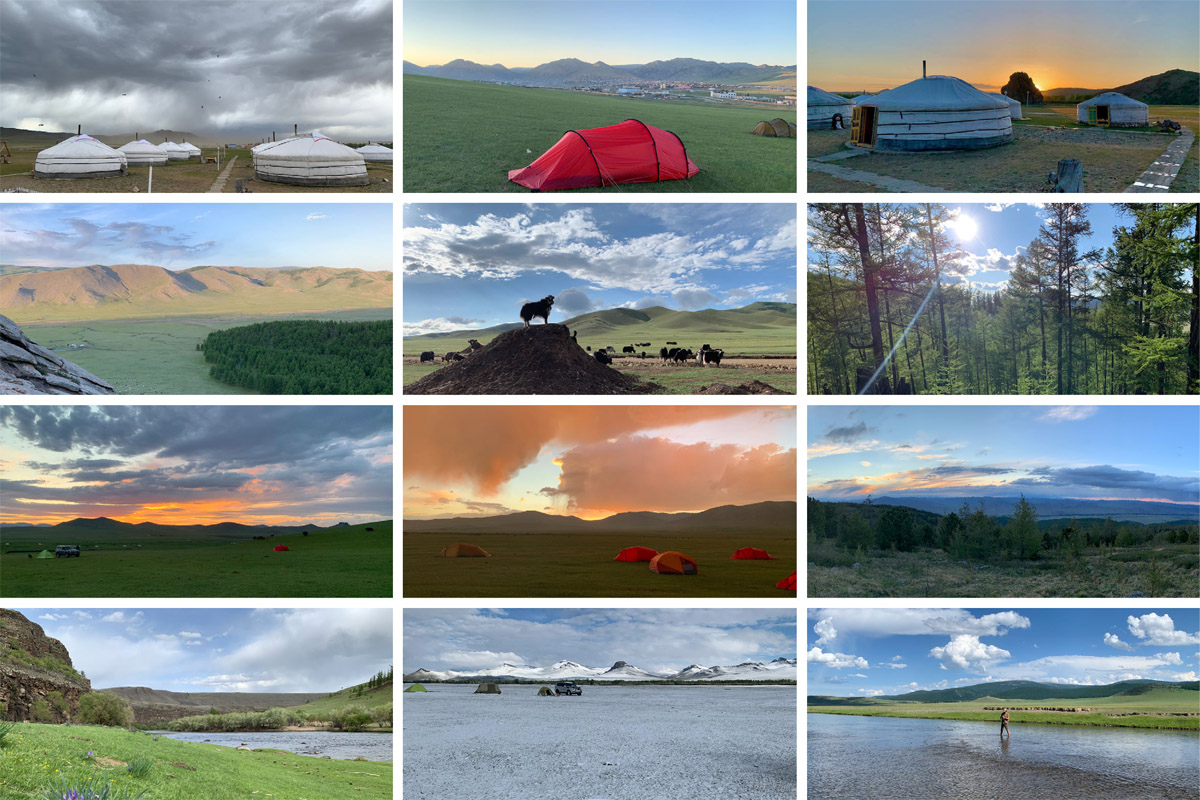 A collage of the landscapes Fran and his colleagues took in while doing research in Mongolia. Top row (left to right): a wind storm over the gers (Mongolian houses); a tent with a view; a sunset over the gers. Row 2 (L to R): the view of a valley full of wild horses; a yak atop a hill; a view of the forest. Row 3 (L to R): a Mongolian landscape with colorful sky; sunset over the team's tents; an evening with local residents. Row 4 (L to R): the Chulutt River; Fran in front of a snow covered landscape; Fran flying the drone from the river.
A collage of the landscapes Fran and his colleagues took in while doing research in Mongolia. Top row (left to right): a wind storm over the gers (Mongolian houses); a tent with a view; a sunset over the gers. Row 2 (L to R): the view of a valley full of wild horses; a yak atop a hill; a view of the forest. Row 3 (L to R): a Mongolian landscape with colorful sky; sunset over the team's tents; an evening with local residents. Row 4 (L to R): the Chulutt River; Fran in front of a snow covered landscape; Fran flying the drone from the river. Before Fran could take in the sunsets and the culture, he worked with GIS software to produce maps to help select the various sites the team would study. Due to experience with drones as a hobby, he also became the team’s de facto drone pilot. Despite all of the advanced work, nothing could prepare him for the experience of being in Mongolia and the many adventures that lay ahead.
“I was mostly focused on my specific duties at the beginning, producing maps, which allowed me to have an idea of the geography and ecosystems of the study sites, but I didn’t have a lot of time to do my own research on the culture, I was just going to discover it by myself,” Fran said. “It was a little bit unexpected how tight the schedule was. We were working all the time, there were just too many things to do. We were organizing workshops, taking pictures of everything, recording videos, audio, etc.
“But then, for example, we were planning to do the sensor deployment in the forest and the herders invited us to an Ovoo, a Buddhist ceremony on the top of a sacred mountain. All of a sudden, I was riding a horse with all my recording equipment piled on top of me and climbing the sacred mountain with these monks and herders, who spontaneously started singing beautiful songs (click to listen), which I recorded with binaural microphones pinned to my ears.”
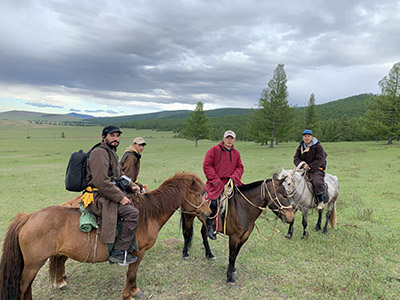 The ride up the sacred mountain and the culture shock once he arrived there brought Fran an array of emotions.
The ride up the sacred mountain and the culture shock once he arrived there brought Fran an array of emotions.
“This was the most beautiful part of the year there because you have wildflowers everywhere on the mountain and that was dreamlike,” he recalled. “It was a little bit scary at the same time because it had been like 17 years since the last time I went horseback riding. I didn't remember everything and I had to do a lot of sound and video recording while on the horse. They wanted to get to the top quick, so sometimes they would just grab our horses with a cord and start sprinting with the horses uphill. That was very dangerous because the terrain was rocky and unstable. I was like ‘I'm gonna die here,’ while trying my best to get nice recordings. That was the most difficult field recording I’ve ever made, but it was very a very interesting experience.
“We also had to spend the night without a tent. I was planning to take my tent and sleeping bag and they said, ‘no, there's no room for that. We don't have cargo horses. You have your own horse and that's it.’ They lent me a winter deel, which is the traditional clothing they use, and they taught us how to use the deels to cover ourselves in the freezing temperatures that night. You have to kind of spoon with other people and use the deels in layers so you can avoid hypothermia. We survived. The next day we woke up around 5 a.m. for 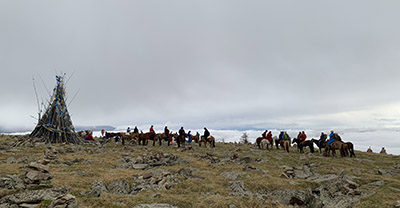 the last section of our ride to the top. When we got there, we saw three Lamas (Buddhist monks) singing and greeting the herders as they arrived to praise the Ovoo, a pyramid-like structure made out of long, straight branches, where they share food and dairy products and offer these to the Ovoo as well. The view from the top of the mountain was incredible.”
the last section of our ride to the top. When we got there, we saw three Lamas (Buddhist monks) singing and greeting the herders as they arrived to praise the Ovoo, a pyramid-like structure made out of long, straight branches, where they share food and dairy products and offer these to the Ovoo as well. The view from the top of the mountain was incredible.”
The day after the ceremony, Fran was called on to team up with his labmate Sam Lima to use their drone skills to help find a missing herder.
“My butt was destroyed because of the ride, but the next day I had to ride a horse again and climb another mountain,” he said. “This was like a whole day on a horse because there was a herder that had gotten lost a couple of days before and they couldn't find him, so they wanted us they asked us to use the drone to help in the search. We climbed the mountain and this time it was snowing. We didn't find the herder, but another group that was searching in the same day, found his body. We climbed down the mountain under dark clouds and a cold rain.”
Working with the drone was not always smooth sailing.
“Flying the drone and troubleshooting was difficult, because our drone failed after some fights, it just randomly fell to the ground and broke,” Fran explained. “Our translator was very helpful and she arranged for us to rent another drone from Ulaanbaatar so we could solve that, but we had to troubleshoot a lot because it was a used drone that we were not familiar with. And it’s not like I was flying the drone from a spot by the car, I had to climb up and down all the hills, up and down every day for several days. We were working against the clock, so that was very challenging and my knees are still sore, but it was a good experience.”
The method of research employed by the Mongolia team allows them to truly embed themselves into the native culture, working with the local government, the herders and the community in a collaborative way.
“Mongolia was very special because it was like a new world,” Fran said. “I knew a little bit about the culture and nature just because of pictures and documentaries, but being there is very different. They have very diverse landscapes. Fortunately, we had the resources to have enough help. The tour crew was very helpful with the logistics and connecting with the locals. Our translators were very good as well so navigating those waters was smooth.
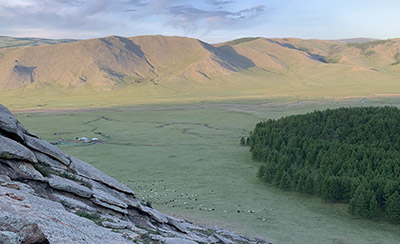 “The culture was very interesting, how these people practice nomadic ways of life that they have been doing for centuries, and keep doing so the same way with despite incorporating some technology. They have solar panels to store their dairy products. They have motorcycles and vehicles, but essentially their lifeway and how they move through the landscape remains pretty much the same. Perhaps what impressed me the most was how they relate to nature, the importance of nature to them, how they keep their culture alive and their sense of community. We had several collaborators, scientists and researchers from Mongolia and if you’d see them a couple of days after we first met the locals, they were hanging out like they were family. They were so warm and close to each other and they made you feel like that as well.”
“The culture was very interesting, how these people practice nomadic ways of life that they have been doing for centuries, and keep doing so the same way with despite incorporating some technology. They have solar panels to store their dairy products. They have motorcycles and vehicles, but essentially their lifeway and how they move through the landscape remains pretty much the same. Perhaps what impressed me the most was how they relate to nature, the importance of nature to them, how they keep their culture alive and their sense of community. We had several collaborators, scientists and researchers from Mongolia and if you’d see them a couple of days after we first met the locals, they were hanging out like they were family. They were so warm and close to each other and they made you feel like that as well.”
With Fran’s background in music, he was particularly touched by the singing of the local residents.
 “I was a music teacher before coming to Purdue so it struck me that music is very important for them not only in a performative way but also in daily life,” he shared. “They hang out at least once a week at night and sit around a bonfire and they sing, everyone sings. It's an honor just to be sitting there where everyone joins in to share beautiful songs. It was very special. One night I asked them if they knew a song related to birds because I love birds and my research interest is on the role of birdsongs in their sense of place and attachment to the homeland. Before I finished asking, one of the best singers started singing a beautiful song about the homeland the bird songs that make them homesick. After a couple of verses, everyone joined the chorus with beautiful voices and the crescendo was pushing my emotions so hard that I simply couldn’t hold back my tears. It was like they were forcing me to cry, just by making it more beautiful every passing second. Then next day they were apologizing because they thought that I was crying because I was sad. I had to explain that the song and their voices were just ridiculously beautiful. I regret not having my recorder with me that night, but that makes it more special, I guess.”
“I was a music teacher before coming to Purdue so it struck me that music is very important for them not only in a performative way but also in daily life,” he shared. “They hang out at least once a week at night and sit around a bonfire and they sing, everyone sings. It's an honor just to be sitting there where everyone joins in to share beautiful songs. It was very special. One night I asked them if they knew a song related to birds because I love birds and my research interest is on the role of birdsongs in their sense of place and attachment to the homeland. Before I finished asking, one of the best singers started singing a beautiful song about the homeland the bird songs that make them homesick. After a couple of verses, everyone joined the chorus with beautiful voices and the crescendo was pushing my emotions so hard that I simply couldn’t hold back my tears. It was like they were forcing me to cry, just by making it more beautiful every passing second. Then next day they were apologizing because they thought that I was crying because I was sad. I had to explain that the song and their voices were just ridiculously beautiful. I regret not having my recorder with me that night, but that makes it more special, I guess.”
Working in a diverse research group and also in a collaborative way with the native people offered a new scientific experience for Fran.
“Research-wise it was very interesting to be exposed to a working group of people with different backgrounds and at the same time learning how to collaborate with local people, who are not professional researchers, and make them an active part of the research,” he said. “One of the most important features of this project is transdisciplinarity. We have rangeland ecologists, anthropologists, soundscape ecologists, and ethnomusicologists working together. The project focuses on co-produced knowledge. We work with the locals, with the herders, and their decisions matter, from the study design to sensor deployments to how we are going to share the findings. Everything goes through them as well. That's an experience that is not easy to find in natural sciences, because traditionally you go to a place, do your research and then leave. You don't necessarily get to interact a lot with people unless you need something from them. I feel very lucky to experience a transdisciplinary and co-produced fieldwork like this.”
 Fran Rivas doing research in Mongolia. Top row (Left to right): Fran on horseback; Fran with the drone controller; enjoying a break at the end of the day; Fran and labmate Sam Lima with deer stones. Row 2: Fran on horseback with his gear preparing to ride up the sacred mountain; Fran presenting at the team's organizational meeting; Fran using a monocular; Fran with friends; Fran with a friend next to a ger; Row 3: Research team doing the are you listening pose; research team checking a sensor; Fran with musicians after a recording; Fran with a golden eagle while dressed in his traditional deel.
Fran Rivas doing research in Mongolia. Top row (Left to right): Fran on horseback; Fran with the drone controller; enjoying a break at the end of the day; Fran and labmate Sam Lima with deer stones. Row 2: Fran on horseback with his gear preparing to ride up the sacred mountain; Fran presenting at the team's organizational meeting; Fran using a monocular; Fran with friends; Fran with a friend next to a ger; Row 3: Research team doing the are you listening pose; research team checking a sensor; Fran with musicians after a recording; Fran with a golden eagle while dressed in his traditional deel. The trip to Mongolia presented many unexpected opportunities.
“This trip gave me a better vision of what it looks like to be a Mongolian and that was beautiful,” Fran shared. “I fell in love with the people and also the nature they call home. I learned a lot by observing and reading about the relative abundance and presence of wildlife. Some of the birds that I dreamed of watching since I was a kid, I saw them there, some of them unexpectedly. Like the bearded vulture, for example, it's a beautiful species that is endangered in most of its range, so having the opportunity to observe and to take pictures of them was a dreamlike experience.”
While encountering birds in nature was special to Fran, he also had a chance to get up close to a Golden Eagle in captivity.
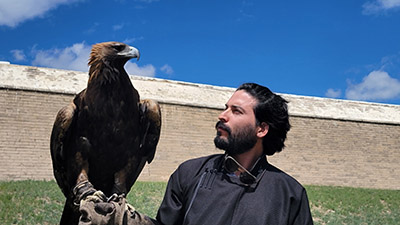 “Our translator knew that I was crazy about birds and then on our last day when we were going back to Ulaanbaatar, she said in this place, the ancient capital, there's a lot of souvenirs stores and there are some eagles there you can take pictures with,” he said. “I was very excited because I had never seen a golden eagle before. I was impressed by their size. I put on my deel that I bought in the Tsetserleg, the province’s capital, and took pictures with the eagle. It was a little bit sad because eagles are captured from the wild and they use them for falconry or for hunting for some years and then they set them free. I don't know if that's the case with these eagles that are for tourism but I couldn't miss the chance. It was a contradiction, but it was nice.”
“Our translator knew that I was crazy about birds and then on our last day when we were going back to Ulaanbaatar, she said in this place, the ancient capital, there's a lot of souvenirs stores and there are some eagles there you can take pictures with,” he said. “I was very excited because I had never seen a golden eagle before. I was impressed by their size. I put on my deel that I bought in the Tsetserleg, the province’s capital, and took pictures with the eagle. It was a little bit sad because eagles are captured from the wild and they use them for falconry or for hunting for some years and then they set them free. I don't know if that's the case with these eagles that are for tourism but I couldn't miss the chance. It was a contradiction, but it was nice.”
Another aspect of the Mongolian landscape that stuck out to Fran was the weather.
“The weather there would change overnight,” he recalled. “When we arrived it was sunny and warm, then the next day it was stormy and the third day it was snowing! All this in the summer. It was kind of crazy. In 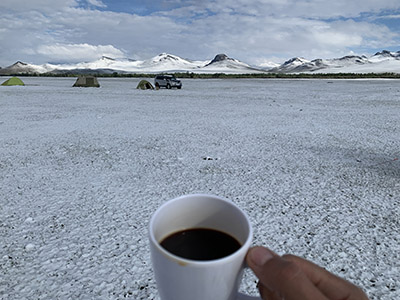 the field, one day we were in the middle of a grassland camping and in the morning I heard sounds of something in the tent. I thought there were goats trying to bite something, because there were goats everywhere, but then I realized it was just snow falling in blocks on the sides of the tent. The whole landscape was covered in white, the mountains, the valleys, everything. That was beautiful too.”
the field, one day we were in the middle of a grassland camping and in the morning I heard sounds of something in the tent. I thought there were goats trying to bite something, because there were goats everywhere, but then I realized it was just snow falling in blocks on the sides of the tent. The whole landscape was covered in white, the mountains, the valleys, everything. That was beautiful too.”
Throughout his summer in Mongolia, Fran was constantly reminded that he had made the right decision in leaving behind his career as a music teacher and coming to the United States to study soundscapes.
“I love teaching and I love sharing experiences and ideas with the youth, but at the same time, I was in the classroom from 8 to 5 and then two more hours of meetings with other teachers, etc. I needed to be outside. Now I'm doing that and I'm very happy.
“I was formulating my dissertation questions before this trip and I was supposed to come back with clearer ideas of what I wanted to do because some of the experiences might change my mind in that realm. My interest is, for the most part, what is the role of specific sounds of some animals, in the sense of topophilia, which is the love for the homeland. I think it is a very interesting topic and I haven’t seen any authors focusing on it in the literature or at least not in the way that I want to focus on it. Meeting these people and how they relate to nature and how the music expresses all these things was very telling. For example, a song that they sang about the bird was a song about the homeland, how the bird songs reminds them of their youth with their parents. That's exactly what I want to study for my research.”
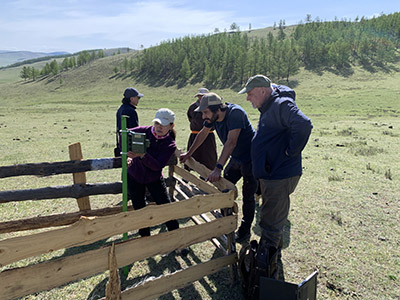 Fran will go back to Mongolia next year, but first, he has trips planned to Tanzania and Bangladesh as a research assistant on a NASA biodiversity grant, titled “Multi-sensor biodiversity framework developed from bioacoustic and space-based sensor platforms.” The three-year project involves preparing data, building and validating habitat maps, developing habitat biodiversity models, testing hypotheses and creating a biodiversity framework. This work will fill a large gap in the understanding of the dynamics of landscapes and animal presence and activities over time by developing phenology models for plants and animals at major terrestrial biomes on Earth.
Fran will go back to Mongolia next year, but first, he has trips planned to Tanzania and Bangladesh as a research assistant on a NASA biodiversity grant, titled “Multi-sensor biodiversity framework developed from bioacoustic and space-based sensor platforms.” The three-year project involves preparing data, building and validating habitat maps, developing habitat biodiversity models, testing hypotheses and creating a biodiversity framework. This work will fill a large gap in the understanding of the dynamics of landscapes and animal presence and activities over time by developing phenology models for plants and animals at major terrestrial biomes on Earth.
“I plan to do one of my dissertation chapters in Tanzania. This will be a little bit different kind of research, more related to remote sensing and how the wildfires change the soundscapes,” he said. “But, as I see it, it is all connected in the big topic of human soundscape interactions. Humans can transform the soundscape by transforming the land doing activities like setting a grassland on fire every year, like in several regions of Tanzania. Also, in many ways, the soundscapes affect individuals and influence the culture, so it's a two-way relationship. Next year, we plan to go back to Mongolia to finish the field work and I plan to stay for a longer period to work on my research.”
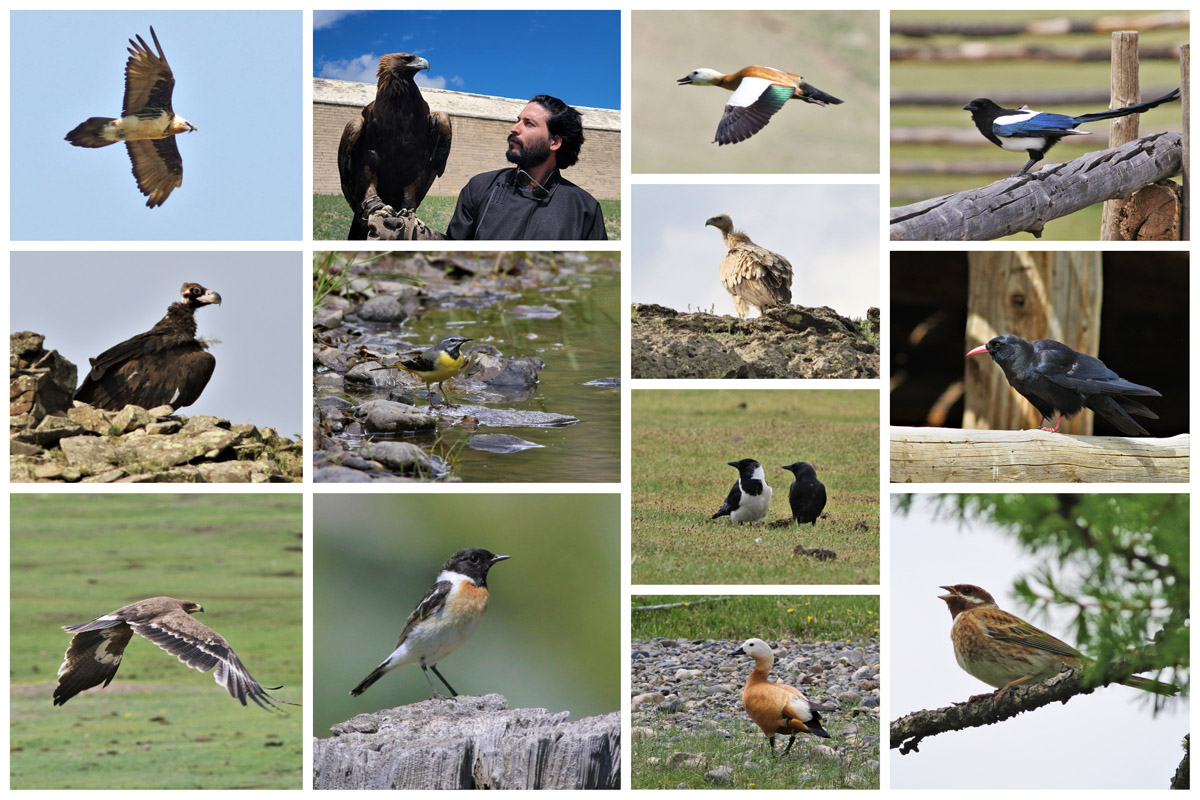 A collage of the birds Fran saw in Mongolia. Top row: a Bearded Vulture in flight; Fran holding a Golden Eagle; a Ruddy Shelduck; a Common Magpie. Second row (L to R): a Cinereus Vulture; a Grey Wagtail; a Himalayan Griffon; a Red-Billed Chough. Third row (L to R): A Steppe Eagle; a Siberian Stonechat; Daurian Jackdaws; a Ruddy Shelduck; and a Pine Bunting
A collage of the birds Fran saw in Mongolia. Top row: a Bearded Vulture in flight; Fran holding a Golden Eagle; a Ruddy Shelduck; a Common Magpie. Second row (L to R): a Cinereus Vulture; a Grey Wagtail; a Himalayan Griffon; a Red-Billed Chough. Third row (L to R): A Steppe Eagle; a Siberian Stonechat; Daurian Jackdaws; a Ruddy Shelduck; and a Pine Bunting 





